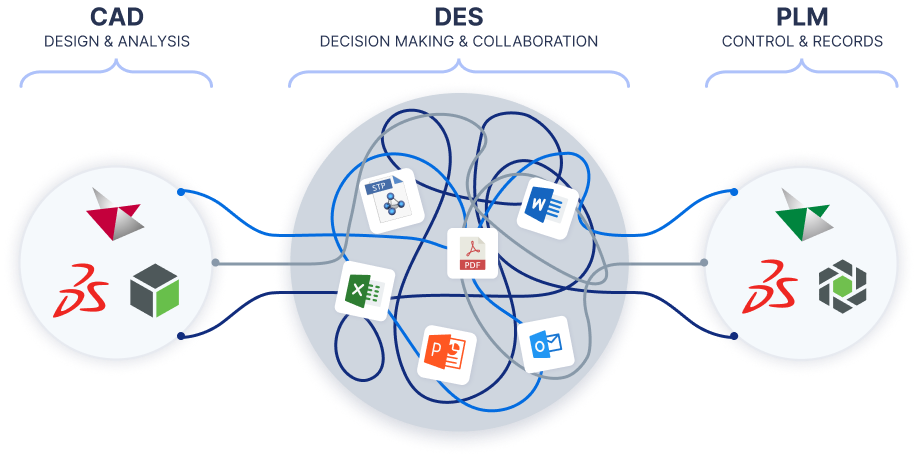Sifting through email is costing you an on-time product launch


Still sifting through email threads and PowerPoint slides to find that one design review comment?
87% of engineering teams spend multiple hours to days finding the right data to justify a specific design decision.
Now, extend that over hundreds of design comments. This isn’t just a frustration for your engineering team. This is costing teams hundreds of thousands of dollars in design reworks and bloating product development timelines.
There’s a better way.
The cost of sifting through emails
So what if your engineers spend a couple days sifting through emails and slides – it’s part of the job, right?
But, what if there’s a connection between those searches and NPD launch delays?
In a recent research report, engineering leaders revealed key NPD cycle failures:
- 90% of companies experience product launch delays due to late-stage design changes
- 43% of design feedback is never tracked or addressed.
- Most companies are not using PLM at all for NPD – and are instead using spreadsheets, PowerPoints, meetings and email.
Remember how 87% of engineering teams spend hours to days trying to find the right information about a specific design decision?
If we tie the above revelations together:
- It takes so long to find information because it’s buried in email threads, PowerPoint slides and meeting notes. Or worse, was never documented at all.
- Because it’s too difficult to document feedback, 43% is never tracked or actioned.
- Then, critical design problems aren’t resolved
- Those problems pop up again during a late stage pilot build
- Now, it’s too expensive or time-consuming to fix and the project is delayed.
So, what’s the solution?
Design Engagement as a System
To fix this problem, you need a new approach to design reviews.
And this approach is not better use of PLM or more meetings – strategies only 17% of engineering leaders believe would be effective.
It’s a better tool for design review.

These same engineering leaders agree a better tool is needed to: document design feedback, communicate design intent, track and implement design feedback, and communicate design changes.
That tool is a Design Engagement System, or DES.
A DES is a system purpose-built to help people engage – not just with data, but with each other – to make great design decisions.
Meaning, a DES:
- It’s frictionless. It’s easy to get data in and out, and you don’t need to download anything to participate in a review. That means infrequent users can still help you make decisions.
- It’s contextual. Reviews are contextual, because you pull in all the files and feedback you need to make a decision and visualize it the way you want. Feedback is contextual because it’s pinned to model geometry.
- It replaces sequential workflows with engaging reviews. Everyone can review and markup the same file at the same time (or asynchronously in parallel). Because it’s a single platform (vs. many point solutions), users don’t have to learn hundreds of workflows.
- It’s self-documenting. Every piece of feedback is captured as a unique object with all of the context required to understand it automatically, as a by-product of doing a review. Files, feedback, and review activity roll up to a comprehensive review object.
A DES isn’t built to control product data – you already have PLM for that. Instead, it allows you to interrogate the right data with the right people in real-time or asynchronously. With a DES, decisions are made with context, input from the right people, and as early as possible in the process.
CoLab as a DES
When it comes to a DES, CoLab is the only one selected by companies like Schaeffler, Ford Pro, Hyundai, Komatsu and Polaris.
These companies choose CoLab because it’s purpose built for fast, effective design review. Using CoLab as their DES, multiple engineers, designers, and other stakeholders can review designs together and build off one another's feedback.
CoLab makes it easy to review the right data – 3D models and 2D drawings – with all the right people, capture useful feedback, and track issues through to action. CoLab pulls together design discussions previously lost in emails, spreadsheets, and notebooks into a single platform that integrates back into PLM.
Moreover, with CoLab’s customer support team, no engineering team is left to configure these processes alone. Your CoLab team is a partner throughout your DES journey.
What’s next?
If you’re ready to see how a DES can transform the way your engineering team works, here’s how the process works with CoLab.
- Every CoLab DES conversation starts with a discovery call. During this call, a technical expert will understand your team’s challenges with design review today
- Then, we’ll tailor a demo to address those challenges. This demo includes you, of course, but also some key members from your team who can speak to your challenges in greater detail and vet CoLab as the solution.
- Finally, we do a workshop with more members of your team. This is the fun part! During this workshop, your team will each have temporary CoLab licenses and participate in a sample design review. You and your team will be guided through key features and use cases right inside the CoLab platform.
If you’re ready, you can schedule a discovery call with a CoLab technical expert.







